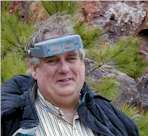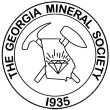Graves Mountain,
Lincolnton, GA

Report on some trips to Graves Mountain
by Dr. Henry Barwood, GMS Member
Sent Wednesday, July 21, 1999 12:47 PM
Thought you might be interested in my recent trips to Graves Mountain to collect. I arranged for small groups of mineral collectors to visit on June 12 (1999) and recently on July 17 (1999).
June 12 (1999) the weather was very cooperative and it was cloudy and overcast for most of the day. This kept the temperatures in the bearable 80's. We examined the West pit in the morning and found lots of holes where rutile is being mined by the more diligent collectors. The North wall has collapsed and obscured most of the lazulite/woodhouseite zone. A small pit in the floor that yielded some excellent micros was backfilled. My son worked a pyrophyllite?quartz?rutile zone in the South wall that produced some good pyrophyllite, but little else. The walls have become extremely unstable from pot?hole collecting and none of our group risked collecting in the more productive rutile areas. By mid?afternoon we had little to show except some barite xls. and a few promising looking specimens that had micro woodhouseites.
About 3PM we retired to the shade to eat lunch and recover. We decided to give the East pit one last shot to see if there were any interesting specimens to be had. Lucky us! Someone had dug a trench looking for lapidary grade lazulite and had thrown out vuggy rock with variscite and crandallite. My son and I worked until nearly 7PM recovering what we could. Finally exhaustion and the image of a small car with broken springs forced us to stop.
When cleaned, these specimens revealed angular cavities (the so?called "anhydrite" casts) that contained colorless, light green, dark green, blue (from lazulite inclusions) and red (from rutile inclusions) specimens of variscite crystals. The variscites range up to 10 x 10 x 12mm in size, although the best specimens are in the 4?6mm size and covering cavities up to several cm in diameter. The material also contained massive and crystalline crandallite, massive woodhouseite, pyrite, excellent blood?red rutile micros, and several unknowns.
A second trip was arranged for July 17 (1999), despite predictions of extremely hot weather, to see if more variscites could be recovered. This trip all seven micromounters concentrated on the East pit. We recovered lots of specimens, but none quite as nice as the initial discovery. Much of this material has yet to be even cleaned, so there may be some surprises. By late afternoon we had pretty much exhausted the "easy pickings" in the area. We also found some nice lapidary grade lazulite, barite, hematite and chrome (?) pyrophyllite. The weather also cooperated and it was cloudy all day and barely reached 80 degrees!
Graves Mountain continues to produce amazing specimens. These are by far the largest variscite crystals I have ever seen and I suspect that they are, by variscite standards, world class. I hope to have a web page up before too long that has photos of the phosphate minerals and other "micros" from there.
Go now to this locality. I do not think it will be with us indefinitely! I have witnessed a near death when a boulder collapsed and it is only time before someone is squashed trying to dig rutile out of the high wall.

Let's Dig!
Copyright © Georgia Mineral Society, Inc.
